2014 MITSUBISHI LANCER SPORTBACK wheel
[x] Cancel search: wheelPage 379 of 422
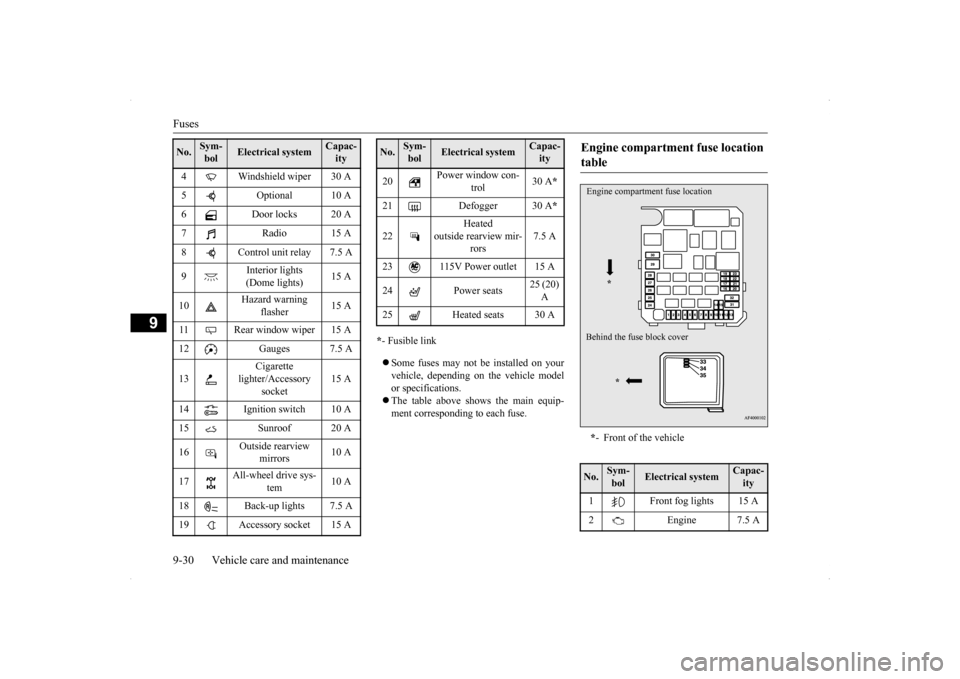
Fuses 9-30 Vehicle care and maintenance
9
* - Fusible link Some fuses may not be installed on your vehicle, depending on the vehicle model or specifications. The table above shows the main equip- ment corresponding to each fuse.
4 Windshield wiper 30 A 5 Optional 10 A 6 Door locks 20 A 7Radio15 A8 Control unit relay 7.5 A 9
Interior lights (Dome lights)
15 A
10
Hazard warning
flasher
15 A
11 Rear window wiper 15 A 12 Gauges 7.5 A 13
Cigarette
lighter/Accessory
socket
15 A
14 Ignition switch 10 A 15 Sunroof 20 A 16
Outside rearview
mirrors
10 A
17
All-wheel drive sys-
tem
10 A
18 Back-up lights 7.5 A 19 Accessory socket 15 ANo.
Sym- bol
Electrical system
Capac-ity
20
Power window con-
trol
30 A
*
21 Defogger 30 A
*
22
Heated
outside rearview mir-
rors
7.5 A
23 115V Power outlet 15 A 24 Power seats
25 (20) A
25 Heated seats 30 ANo.
Sym- bol
Electrical system
Capac-ity
Engine compartment fuse location table * - Front of the vehicle
No.
Sym- bol
Electrical system
Capac-ity
1 Front fog lights 15 A 2 Engine 7.5 AEngine compartment fuse location
*
Behind the fuse
block cover
*
BK0200700US.bo
ok 30 ページ 2013年2月15日 金曜日 午後12時17分
Page 388 of 422
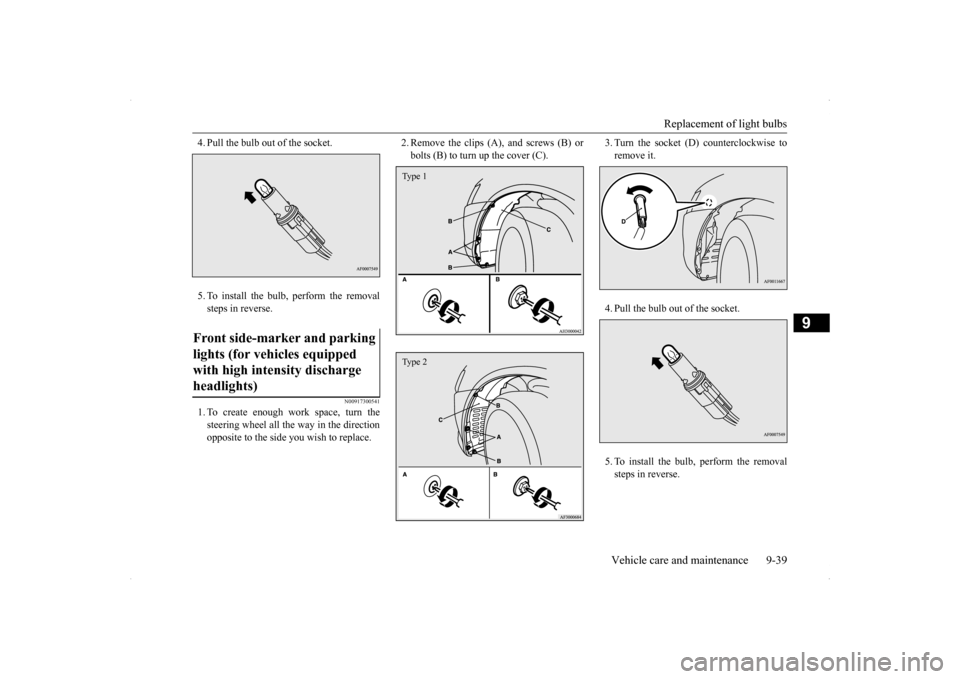
Replacement of light bulbs
Vehicle care and maintenance 9-39
9
4. Pull the bulb out of the socket. 5. To install the bulb, perform the removal steps in reverse.
N00917300541
1. To create enough work space, turn thesteering wheel all the way in the directionopposite to the side you wish to replace.
2. Remove the clips (A), and screws (B) or bolts (B) to turn up the cover (C).
3. Turn the socket (D) counterclockwise to remove it. 4. Pull the bulb out of the socket.5. To install the bulb, perform the removal steps in reverse.
Front side-marker and parking lights (for vehicles equipped with high intensity discharge headlights)
Type 1Type 2
BK0200700US.bo
ok 39 ページ 2013年2月15日 金曜日 午後12時17分
Page 399 of 422

Cleaning the outside of your vehicle 9-50 Vehicle care and maintenance
9
clean water and a car washing mitt or sponge, wash the vehicle from top to bottom. Use a mild car washing soap if necessary. Rinse thoroughly and wipe dry with a cham-ois or soft cloth. After washing the vehicle, carefully clean the joints and flanges of the doors, hood, etc., where dirt is likely toremain.
Salt and other chemicals spread on winter roads in some geographical areas can have adetrimental effect on the vehicle underbody. You should flush the underbody with a high pressure hose every time you wash the out-side of your vehicle. Take special care to remove mud or other debris which could trap and hold salt andmoisture.After washing your vehicle, wipe off all waterdrops from the rubber parts around the doors to prevent the doors from freezing.
N00946000218
Wax your vehicle once or twice a year, or when water does not bead up on the paint.
CAUTION When washing the underside of your vehicle or the wheels, wear a pair of gloves to pro- tect your hands. If your vehicle has rain sensor wipers, place the wiper switch lever in the “OFF” positionto deactivate the rain sensor before washing the vehicle. Otherwise, the wipers will oper- ate in the presence of water spray on thewindshield and may get damaged as a result. Never spray or splash water on the electrical parts in the engine compartment. This may damage them. Be careful also when washing the underbody. Do not spray water into theengine compartment. Avoid automatic car washers that use rotat- ing brushes. These brushes may scratch the paint surface and make it dull. Scratches are more noticeable on darker col- ored vehicles.
Some hot water washing equipment uses high pressure and heat to clean your vehicle. This heated water may damage your vehi- cle’s resin parts. It can flood the interior of the vehicle. Therefore, be sure of the follow-ing:• Keep the washing nozzle at least 20 inches(50 cm) away from the vehicle body.• When washing around the door glass, holdthe nozzle at a distance of more than 20 inches (50 cm) and at right angles to the glass surface.
When using high-pressure water to wash a vehicle equipped with the F.A.S.T.-key sys-tem, keep the water from spraying on the open button on the rear hatch. This could cause the rear hatch
to open and flood the
inside of the rear hatch. Make sure to do the following when using an automatic car wash, with help from either this manual or the car wash operator, to avoid damaging your vehicle:• Fold the outside rear-view mirrors.• Put down (except for vehicles equipped with SIRIUS satellite radio antenna only) or remove the antenna.• If your vehicle is equipped with rearspoiler, check with the car wash operator before using the car wash.• If your vehicle has rain sensor wipers, placethe wiper switch lever in the “OFF” posi- tion to deactivate the rain sensor.CAUTION
During cold weather
NOTE
When the door is frozen, opening it by force may tear off or crack the rubber gasket installed around the door. Pour warm waterto melt the ice. Be sure to thoroughly wipe off the water after opening the door. To pre- vent freezing of the weatherstripping on thedoors, hood, etc., treat with silicone lubri- cant.
Waxing
BK0200700US.bo
ok 50 ページ 2013年2月15日 金曜日 午後12時17分
Page 401 of 422
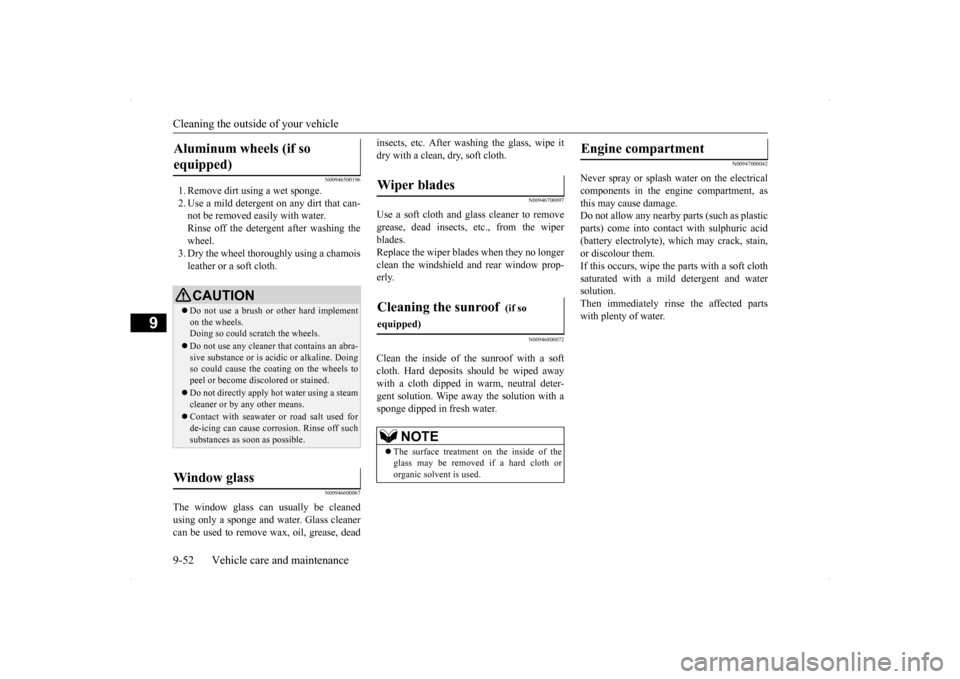
Cleaning the outside of your vehicle 9-52 Vehicle care and maintenance
9
N00946500196
1. Remove dirt using a wet sponge. 2. Use a mild detergent on any dirt that can- not be removed easily with water. Rinse off the detergent after washing thewheel. 3. Dry the wheel thoroug
hly using a chamois
leather or a soft cloth.
N00946600067
The window glass can usually be cleanedusing only a sponge and water. Glass cleanercan be used to remove wax, oil, grease, dead
insects, etc. After washing the glass, wipe it dry with a clean, dry, soft cloth.
N00946700097
Use a soft cloth and glass cleaner to removegrease, dead insects, etc., from the wiper blades. Replace the wiper blades when they no longerclean the windshield and rear window prop-erly.
N00946800072
Clean the inside of the sunroof with a softcloth. Hard deposits should be wiped awaywith a cloth dipped in warm, neutral deter- gent solution. Wipe away the solution with a sponge dipped in fresh water.
N00947000042
Never spray or splash water on the electricalcomponents in the engine compartment, asthis may cause damage. Do not allow any nearby parts (such as plastic parts) come into contact with sulphuric acid(battery electrolyte), which may crack, stain, or discolour them. If this occurs, wipe the parts with a soft clothsaturated with a mild detergent and watersolution. Then immediately rinse the affected parts with plenty of water.
Aluminum wheels (if so equipped)
CAUTION Do not use a brush or other hard implement on the wheels.Doing so could scratch the wheels. Do not use any cleaner that contains an abra- sive substance or is acidic or alkaline. Doing so could cause the coating on the wheels to peel or become discolored or stained. Do not directly apply hot water using a steam cleaner or by any other means. Contact with seawater or road salt used for de-icing can cause corrosion. Rinse off suchsubstances as soon as possible.
Window glass
Wiper blades Cleaning the sunroof
(if so
equipped)
NOTE
The surface treatment on the inside of the glass may be removed if a hard cloth ororganic solvent is used.
Engine compartment
BK0200700US.bo
ok 52 ページ 2013年2月15日 金曜日 午後12時17分
Page 403 of 422
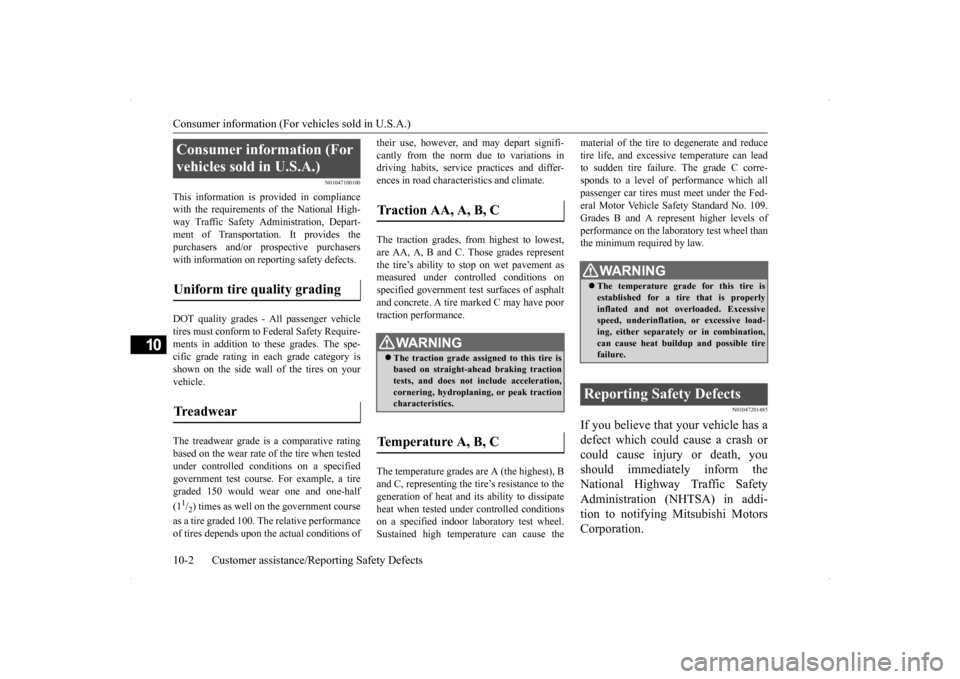
Consumer information (For vehicles sold in U.S.A.) 10-2 Customer assistance/Reporting Safety Defects
10
N01047100100
This information is provided in compliance with the requirements of the National High-way Traffic Safety Administration, Depart- ment of Transportation. It provides the purchasers and/or prospective purchaserswith information on reporting safety defects. DOT quality grades - All passenger vehicle tires must conform to Federal Safety Require-ments in addition to these grades. The spe- cific grade rating in each grade category is shown on the side wall of the tires on yourvehicle. The treadwear grade is a comparative rating based on the wear rate of the tire when tested under controlled conditions on a specified government test course. For example, a tiregraded 150 would wear one and one-half (11/2) times as well on the government course
as a tire graded 100. The relative performance of tires depends upon the actual conditions of
their use, however, and may depart signifi- cantly from the norm due to variations in driving habits, service practices and differ- ences in road characteristics and climate. The traction grades, from highest to lowest, are AA, A, B and C. Those grades representthe tire’s ability to stop on wet pavement asmeasured under controlled conditions on specified government test surfaces of asphalt and concrete. A tire marked C may have poortraction performance. The temperature grades are A (the highest), B and C, representing the tire’s resistance to thegeneration of heat and its ability to dissipate heat when tested under controlled conditions on a specified indoor laboratory test wheel.Sustained high temperature can cause the
material of the tire to degenerate and reduce tire life, and excessive temperature can lead to sudden tire failure. The grade C corre- sponds to a level of performance which allpassenger car tires must meet under the Fed- eral Motor Vehicle Safety Standard No. 109. Grades B and A represent higher levels ofperformance on the laboratory test wheel than the minimum required by law.
N01047201485
If you believe that your vehicle has a defect which could cause a crash or could cause injury or death, you should immediately inform the National Highway Traffic SafetyAdministration (NHTSA) in addi- tion to notifying Mitsubishi Motors Corporation.
Consumer information (For vehicles sold in U.S.A.) Uniform tire quality grading Treadwear
Traction AA, A, B, C
WA R N I N G The traction grade assigned to this tire is based on straight-ahead braking traction tests, and does not include acceleration, cornering, hydroplaning, or peak tractioncharacteristics.
Temperature A, B, C
WA R N I N G The temperature grade for this tire is established for a tire that is properly inflated and not overloaded. Excessive speed, underinflation, or excessive load-ing, either separately or in combination, can cause heat buildup and possible tire failure.
Reporting Safety Defects
BK0200700US.bo
ok 2 ページ 2013年2月15日 金曜日 午後12時17分
Page 408 of 422
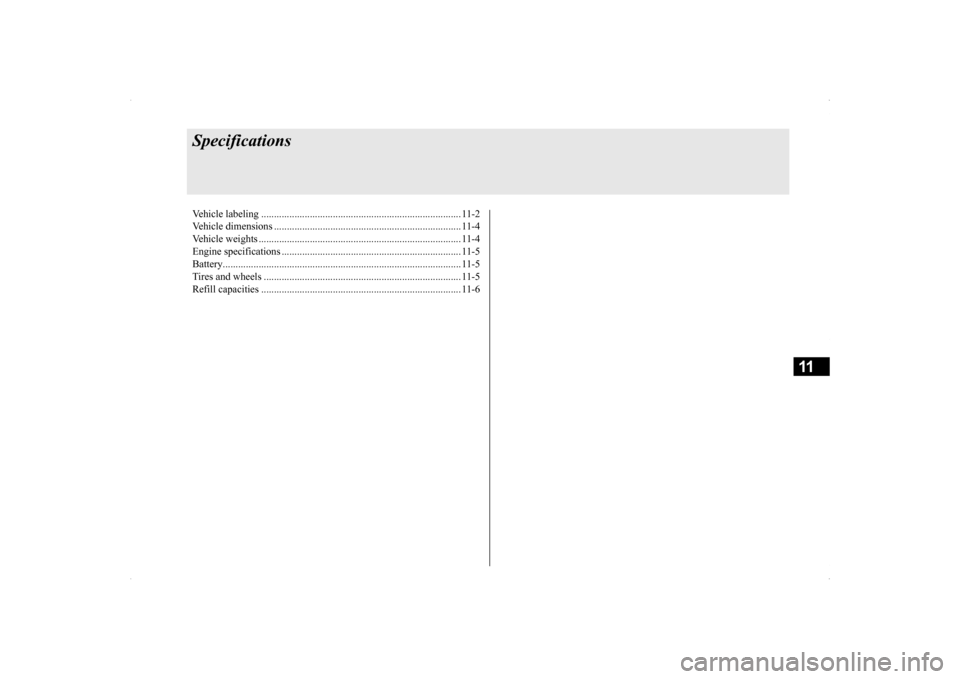
11
SpecificationsVehicle labeling ...............
............................................................... 11-2
Vehicle dimensions ..........
............................................................... 11-4
Vehicle weights ................
............................................................... 11-4
Engine specifications
..............................................
........................ 11-5
Battery........................................
..................................................... 11-5
Tires and wheels ..............
............................................................... 11-5
Refill capacities ...............
............................................................... 11-6
BK0200700US.bo
ok 1 ページ 2013年2月15日 金曜日 午後12時17分
Page 411 of 422
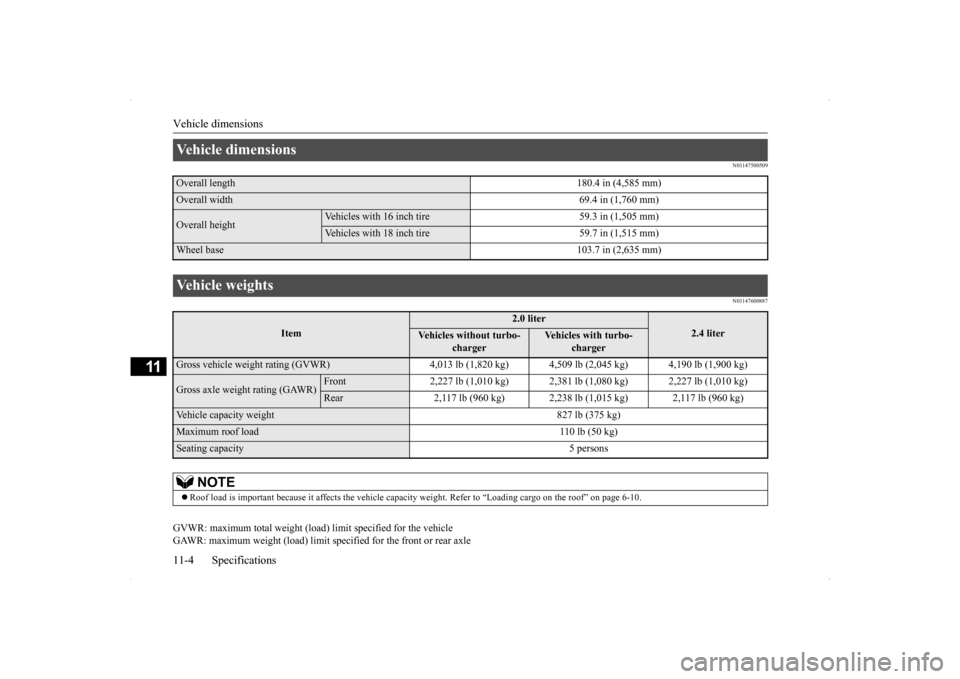
Vehicle dimensions 11-4 Specifications
11
N01147500509 N01147600887
GVWR: maximum total weight (load) limit specified for the vehicle GAWR: maximum weight (load) limit sp
ecified for the front or rear axle
Vehicle dimensions Overall length
180.4 in (4,585 mm)
Overall width
69.4 in (1,760 mm)
Overall height
Vehicles with 16 inch tire 59.3 in (1,505 mm)Vehicles with 18 inch tire 59.7 in (1,515 mm)
Wheel base
103.7 in (2,635 mm)
Vehicle weights
Item
2.0 liter
2.4 liter
Vehicles without turbo-
charger
Vehicles with turbo-
charger
Gross vehicle weight rating (GVWR) 4,013 lb
(1,820 kg) 4,509 lb (2
,045 kg) 4,190 lb (1,900 kg)
Gross axle weight rating (GAWR)
Front 2,227 lb (1,010 kg) 2,381
lb (1,080 kg) 2,227 lb (1,010 kg)
Rear 2,117 lb (960 kg) 2,238 lb
(1,015 kg) 2,117 lb (960 kg)
Vehicle capacity weight 827 lb (375 kg)Maximum roof load 110 lb (50 kg)Seating capacity 5 persons
NOTE
Roof load is important because it affects the vehicle capacity
weight. Refer to “Loading cargo on the roof” on page 6-10.
BK0200700US.bo
ok 4 ページ 2013年2月15日 金曜日 午後12時17分
Page 412 of 422
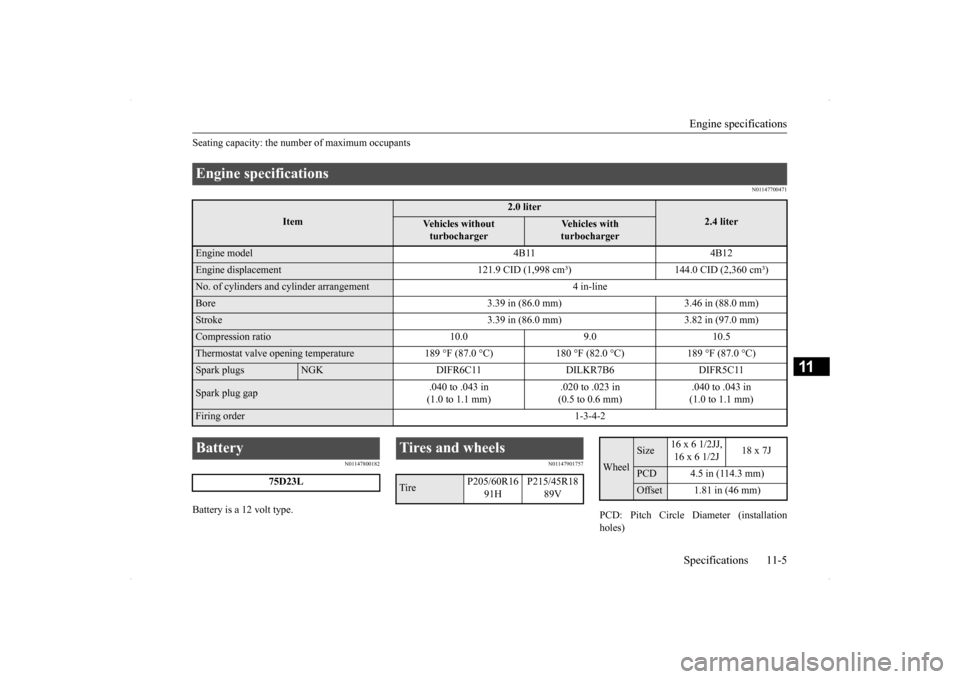
Engine specifications Specifications 11-5
11
Seating capacity: the number of maximum occupants
N01147700471
N01147800182
Battery is a 12 volt type.
N01147901757
PCD: Pitch Circle Diameter (installation holes)
Engine specifications
Item
2.0 liter
2.4 liter
Vehicles without turbocharger
Vehicles with turbocharger
Engine model 4B11 4B12Engine displacement 121.9 CID
(1,998 cm³) 144.0 CID (2,360 cm³)
No. of cylinders and cylinder arrangement 4 in-lineBore 3.39 in (86.0 mm) 3.46 in (88.0 mm)Stroke 3.39 in (86.0 mm) 3.82 in (97.0 mm)Compression ratio 10.0 9.0 10.5Thermostat valve opening temperature 189 °F
(87.0 °C) 180 °F (82.0 °C) 189 °F (87.0 °C)
Spark plugs
NGK DIFR6C11 DILKR7B6 DIFR5C11
Spark plug gap
.040 to .043 in (1.0 to 1.1 mm)
.020 to .023 in (0.5 to 0.6 mm)
.040 to .043 in (1.0 to 1.1 mm)
Firing order
1-3-4-2
Battery
75D23L
Tires and wheels Tire
P205/60R16
91H
P215/45R18
89V
Wheel
Size
16 x 6 1/2JJ, 16 x 6 1/2J
18 x 7J
PCD 4.5 in (114.3 mm)Offset 1.81 in (46 mm)
BK0200700US.bo
ok 5 ページ 2013年2月15日 金曜日 午後12時17分